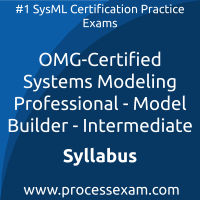 To achieve the professional designation of OMG-Certified Systems Modeling Professional - Intermediate from the OMG, candidates must clear the OMG-OCSMP-MBI300 Exam with the minimum cut-off score. For those who wish to pass the OMG OCSMP Intermediate certification exam with good percentage, please take a look at the following reference document detailing what should be included in OMG SysML MBI Exam preparation.
To achieve the professional designation of OMG-Certified Systems Modeling Professional - Intermediate from the OMG, candidates must clear the OMG-OCSMP-MBI300 Exam with the minimum cut-off score. For those who wish to pass the OMG OCSMP Intermediate certification exam with good percentage, please take a look at the following reference document detailing what should be included in OMG SysML MBI Exam preparation.
The OMG-OCSMP-MBI300 Exam Summary, Sample Question Bank and Practice Exam provide the basis for the real OMG-Certified Systems Modeling Professional - Model Builder - Intermediate exam. We have designed these resources to help you get ready to take OMG-Certified Systems Modeling Professional - Intermediate (OMG-OCSMP-MBI300) exam. If you have made the decision to become a certified professional, we suggest you take authorized training and prepare with our online premium OMG OCSMP Intermediate Practice Exam to achieve the best result.
OMG-OCSMP-MBI300 Exam Summary:
| Exam Name | OMG-Certified Systems Modeling Professional - Intermediate |
| Exam Code | OMG-OCSMP-MBI300 |
| Exam Fee | USD $350 |
| Residents of English-speaking Countries Exam Duration | 105 Minutes |
| All others Exam Duration | 135 Minutes |
| Number of Questions | 90 |
| Passing Score | 55 / 90 |
| Format | Multiple Choice Questions |
| Schedule Exam | Pearson VUE |
| Sample Questions | OMG SysML MBI Exam Sample Questions and Answers |
| Practice Exam | OMG-Certified Systems Modeling Professional - Model Builder - Intermediate Practice Test |
OMG OCSMP Intermediate Syllabus Topics:
| Topic | Details |
|---|---|
BUILDING A BEHAVIORAL MODEL USING THE FULL SET OF SYSML CONSTRUCTS - 33% |
|
| How To Use SysML to Model System Behavior |
- Building An Activity Diagram Using the Full Set of SysML Constructs
- Building A Sequence Diagram Using the Full Set of SysML Constructs
- Building A State Machine Diagram Using the Full Set of SysML Constructs
|
BUILDING A STRUCTURAL MODEL USING THE FULL SET OF SYSML CONSTRUCTS - 29% |
|
| Building the Block Definition Diagram |
- Adding Block Features: Receptions, ordered and unique collections, read only properties, property redefinition, constraint (reference to parametrics below), distributed properties. Block Relationships: Shared vs composite aggregation (white vs black diamond), association blocks and generalization sets. Value Types: Enumerations, structured value types ("position vector" with XYZ structure). Blocks and Behavior: Classifier behavior (See Friedenthal), owned behaviors, activity hierarchies on bdds. Defining instances.
|
| Building the Internal Block Diagram |
- Block Properties: Creating a property specific type and notation for part multiplicities on ibd's. Ports: Flow Ports: Flow specifications and properties, conjugated ports, and compatibility rules including item flows and ports. Standard Ports: Defining required and provided interfaces, typing a port with required and provided interfaces (i.e., with a provided interface and with a classifier with use/realize relationship). Port delegation (for both flow ports and standard ports). Connectors: Nested connector ends, item flows/item properties, conveyed classifiers, typing item properties, ownership of item properties, and connector properties
|
BUILDING A PARAMETRIC MODEL USING THE FULL SET OF SYSML CONSTRUCTS - 11% |
|
|
How To Use Constraints in SysML to Model System Analyses: Defining Constraints on A Block Definition Diagram Using the Full SysML Feature Set
|
- Nesting of constraints, trade study support (Annex E.4), measures of effectiveness, objective functions, alternatives, and constraining flows.
|
BUILDING A REQUIREMENTS MODEL USING THE FULL SET OF SYSML CONSTRUCTS - 10% |
|
| Building A Requirements Diagram Using the Full Set of SysML Constructs |
- Specialized requirements (SysML Annex C: functional, interface, performance, physical and design constraints), establishing requirements traceability (derive, verify, satisfy, refine, trace and containment), tracing requirements in tables and matrixes, representing verification and testing, test context as well as test case.
|
| Building A Use Case Model Using the Full Set of SysML Constructs |
- Relating use cases to behavioral models - activity diagrams and state machines, and relating use cases to requirements.
|
MODEL CONCEPTS - 6% |
|
| Modeling guidelines and Practices | - Application of modeling guidelines and practices |
ORGANIZING A SYSTEM MODEL USING THE FULL SET OF SYSML CONSTRUCTS - 6% |
|
| Building A Package Diagram Using the Full Set of SysML Constructs |
- Package and element import, defining and using view and viewpoint, building and using model libraries, as well as awareness of assessment criteria (e.g., structured queries) and activities.
|
DEFINING STEREOTYPES, PROPERTIES, AND CONSTRAINTS (EXTENSION, SUBCLASS) - 5% |
|
Both OMG and veterans who’ve earned multiple certifications maintain that the best preparation for a OMG-OCSMP-MBI300 professional certification exam is practical experience, hands-on training and practice exam. This is the most effective way to gain in-depth understanding of OMG SysML MBI concepts. When you understand techniques, it helps you retain OMG OCSMP Intermediate knowledge and recall that when needed.
